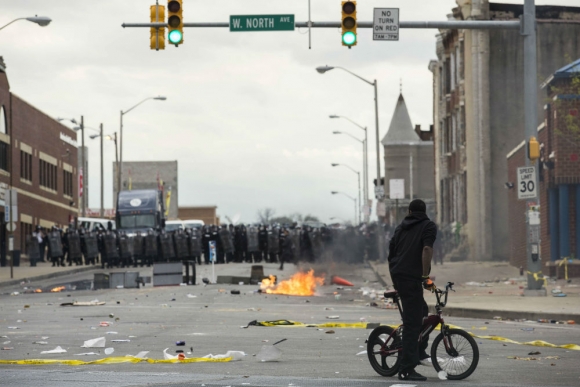By Nathan Lee, TLE Correspondent
Police targeted, stores looted and havoc wreaked across the streets of Baltimore. The past week has been a mass of ugly pictures in Maryland as footage emerge from riots that broke out after the funeral of Freddie Gray, 25, who died after suffering a spinal injury in police custody.
Like the London riots, citizen journalism has played a prominent role in conveying the events which seems to have humanised the uprising. Subsequent media responses have been far more sympathetic with the plight of African Americans living in the city. The National Review lead with “Riot-Plagued Baltimore Is a Catastrophe Entirely of the Democratic Party’s Own Making”, echoing similar headlines across the board that riots such as this, and the earlier instance in Ferguson, Missouri, highlight deeply engrained issues within American society.
Photocredit: B. Scott
One teacher in Baltimore posted on Facebook this week that the response is not unreasonable. Her post reads:
Yesterday morning my class discussed the protests Saturday night and the so-called “Purge” planned for that afternoon. As we debated the merits of violent vs. non-violent resistance, one student said to me, “Ms. Masc, do not give me that MLK bullshit. It has been 40 years and nothing has changed. We are still segregated. We are still killed and there is no justice. It does not matter what I do. No one is listening.” His anger makes sense. His logic is sound. This is what happens when a power system continually denies a group of people their rights.
Photocredit: Tom Darby
The paradox created by the police as being both the cause and the solution to the problem has also raised eyebrows. The Atlantic’s David A Graham questioned: “If police brutality sparked protests, why would anyone expect the police to be able to stop them?” Although Freddie Gray’s death is thought to be the catalyst for the riots, many believe that police may have mishandled protests on Monday, allowing them to escalate and turn into looting and rioting.
Photocredit: Poet Shi
Within this confused and heated environment there is also the side we don’t see; the community response. A Facebook thread has emerged with people posting pictures and posts along with the hashtag #BaltimoreCoverageYouMayNotSee. These pictures are perhaps the most poignant of all when a community faces crisis.
Photocredit: Tom Darby
Photocredit: Marcus J. Guynn

